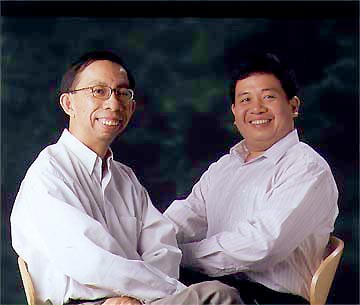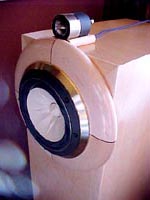|
 |
|
|
|
|
 |
|
|
|
|
|
|
 |
|
 |
|
The Chinese culture is balanced between the twin poles of Confucianism and Taoism. Confucius and Mencius emphasized social consciousness, ethics, righteousness and morale, all the practical matters that regulate peaceful coexistence between humans. Lao Tzu, Chuang Tzu and various other wily circular Chi-breathers extolled the water-course way of living in balance with spirit: Wei wu wei, easy is right, right is easy - take it easy. When the shoe fits, the foot is forgotten.
If you want pomp, circumstance and social gravitas, T.S. Lim's Tian Zhu amplifier is not for you. That shoe will pinch. Its looks and fit'n'finish, while well north of kit central, are still south of the bespoke luxury border. Its all-valve, single-ended pentode nature defies the mainstream even for tube amps. Its Class A power output of 20 watts is more sinewy mountain hermit than comrade chief inspector. Its brand name doesn't carry status symbol cachet.
If you want absolutely beguiling sound with hidden cojones however -- Tian Zhu after all means "Voice from Heaven"
-- this EL34 parallel single-ended with ML6 drivers and 6SL7 predrivers might make quite the altar piece. At $2,980 ($2,235 Singapore-direct if no dealers exist in your country), and to close the Taoist cycle of eternal balance, it's reasonably easy on the pocket book too - if it sounded right. Which it does as we shall shortly explore.
|
|
|
|
|
 |
|
|
"Capturing beauty is like pinning a butterfly.
The husk is secured, the flying is lost."
[from Lao Tzu's Hua Hu Ching]."
|
|
|
Describing the voice of a tube amplifier is like stepping into a particular chapter of the overarcing thermionic gospel. Differences of interpretation remain within each sect, certainly, but the overall gestalt is fixed by the core focus on the beloved master - the output tube. Adventurous designers attempt to break free of such molds. With more or less success, they graft different signatures one atop the other, through the experimental use of uncommon driver or rectifier tubes which impart their own unique flavors to develop the fundamental tenor in unexpected directions. Warns Lim "If you don't know about music, you can forget about the sound". That refers to the Confucian mandate of having to know first-hand what music sounds like while mixing and quelling for realistic results. Lim is a top-shelf harmonica player and was trained as a tenor. He's also a Mahler enthusiast and part of the Mahler Society of Singapore.
|
|
 |
|
To pin this aural butterfly, we learn that Diva Audio's designer [above right] endeavored to wed the 2A3's refinement to the realism and power of the EL34 pentode which is often snubbed by triode cognoscenti who venerate pricier designer bottles of the 300B, 45 or 211 vintages instead. Since he desired beauty & realism, the final Tian Zhu amplifier eventually replaced the vaunted 2A3 driver valves with the British ML6/VT105 from the 1940s. In Lim's words, that update created far higher levels of refinement, beauty, authority and control. CV345 or KT88 output tubes can substitute the EL34s for more power but a different sound.
A look at the images reveals Tian Zhu's garments to be more Bodhidharma than Cheng Panch'iao. A wooden front adorned with bronzed metal, a black carcass with direct-mounted transformers sans caps, simple plastic terminals and a power toggle aft: Functional, demurely dressed, but nothing to impress punters marked by Art Audio's gleaming polished stainless steel or Hovland's architectural glowing blue Lexan chimneys. Explained Lim that the emphasis (from the choice of output tubes to the final appearance) was on producing superior sound for an affordable price.
The chassis choice of mild steel over thick aluminum was based on listening tests that found the thicker material to be listless sounding, the chosen one livelier. Internal components vary from expensive designer to obscure affordable parts, selected for sound and reliability over snob appeal. This includes the binding posts which, while not looking as stout as WBTs or other "in" terminals, were found to sound better. Blackgate "Heart of Muse" capacitors do constitute a possible upgrade, however, this would raise the retail by $1,000 and requires a taller special-edition/special-order chassis to accomodate the larger parts.
The functional appearance aspect is highlighted by the front-mounted RCA inputs, offering the shortest path to the GE 6SL7/ECC35 predrivers while putting the maloik on silly inflexible designer cables that might refuse to bend tightly enough.
My only practical issue with the amp during its Northern New Mexican tenure? A nasty and belligerent ground loop that no combination of floating grounds in the system could exorcise. Contemplating one of the chassis side screws in a moment of attunement with Zeus of the Thunderbolt, I chopped off one lead from my voltmeter, stripped the end, affixed it to said chassis screw and plunged the banana into the loosened star-grounding screw of Lloyd Walker's Velocitor power line conditioner.
|
|
|
|
 |
|
 |
|
 |
|
 |
|
|
|
 |
|
|
|
 |
|
Cheers! This was good medicine without the foul while potent taste of most traditional Chinese herbs. Now I was in the hoped-for graveyard to contemplate the sound of one electron coughing. Thus back in the audiophile reviewing business, with my tattered shingle proudly mounted above the garage (where the local UPS guys take their lunch), I drifted over to my library to cull a few samples that would take The Voice of Heaven through the mortal realms into hell and back.
|
|
Incidentally, this review unit had seen prior duty at CES 2003, in the Rethm room I had covered in hushed tones in my show report. Upon finally meeting there Diva Audio's munificent evangelist Richard Seah whom, months earlier, I had sent a review request for this piece via e-mail, he spontaneously agreed to let me manhandle his baby right after the show. It arrived post-haste directly from the Alexis Park hotel, in a duct-taped carton covered with Asian stickers. Viva le global village where amps from Singapore end up in Taos/New Mexico by way of Sin City. But then, heaven doesn't play favorites - unless you were to adore music. Then all bets are off and special favors are granted!
|
|
|
|
On Lim's behalf, RIchard explained in a subsequent e-mail that the Tian Zhu's favored diet were high-efficiency speakers of 96dB-or-higher ratings though customers with 88-92dB speakers that don't do Mahler, Rock or rave-approved braincell killing would be happy as well. Because of Lim's long-standing admiration for speakers like the Rethm, his work with such designs showed him that pentodes rather than triodes were superior, i.e. more honest realistic output devices. He belabored the point that many tube mavens walk down the path of ultimate refinement to lose touch with reality. Hence he employs the ML6 triodes merely in the driver stage and adopts a higher-power, more linear pentode in the final stage.
|
|
 |
|
|
Mentioned Richard that, when he first met Lim, his personal system was three-times as expensive and "sophisticated", yet the DIva designer's crushed his in terms of performance. He's been a believer ever since and now helps T.S. market his products. |
|
|
|
|
|
 |
|
|
US dealers at present include Cadiz Sound in Woodland Park/Colorado, Concert Sound in San Antonio/Texas, Fidelis AV in Salem/ New Hampshire and Witchdoctor Audio in Berkeley/California. Music lovers abroad should check the Diva Audio website at review's end for global distribution contacts .
|
|
|
 |
|
|
|
|
 |
|
|
|
|
|
|
|
|
|
|
|
|
|
|
|
|
|
|
|
|
|
|
|
|